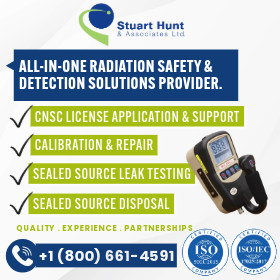Radon Exposure Guidelines: Upcoming Harmony at the Federal Level is a Reminder to all Workplaces to Test for Radon

In October of 2023, the Canadian Government announced their intention to change the Canadian Labour Code (CLC) to harmonize their radon exposure limit with Health Canada’s guidelines. This was welcome news in the radon industry, as the labour code’s existing exposure limit of 800 Bq/m3 has seemed woefully outdated since Health Canada lowered their guideline level to 200 Bq/m3 in 2007.
The CLC exists to protect the rights and well-being of both workers and employers in federally regulated workplaces. The CLC is divided into four parts, one of which (Part II) is exclusively devoted to Occupational Health and Safety. Part II states that employers have a general obligation to protect the health and safety of employees, as well as anyone else who is granted access to the workspace.
Radon, as the leading cause of lung cancer in non-smokers, can pose a serious health threat to anyone who works indoors and should be considered in any Occupational Health and Safety plan. Given that radon comes from the breakdown of uranium in the soil all across Canada, and that no area of the country has been found to be radon free, testing for this radioactive gas should absolutely be conducted in all workplaces.
While the CLC only applies directly to workers in federally regulated workplaces, the good news is that many organizations are already set for the upcoming changes. The federal government has been testing their own buildings, and many other workplaces that come under the jurisdiction of the CLC are in the process of testing. Thanks to this testing, Health Canada released Radon Testing in Federal Buildings – Highlights on their website, which reports that 3.6% of the buildings tested above the guideline. The upcoming harmonization of the CLC and the example set by the federal building testing serve as important reminders to all employers and building owners that testing for radon is an important responsibility.
Our focus can now shift to the provinces, as we encourage them to take action to address radon in workplaces. Some jurisdictions have already set an example. In Ontario, the Occupational Health and Safety Act states that employers must take every precaution reasonable to protect workers, which includes protecting workers from the hazards associated with radon exposure.
In a survey conducted jointly by CARST and the Canadian Radiation Protection Association (CRPA), only 25% of respondents said their workplace had been tested for radon. Testing your workplace for radon doesn’t have to be complicated, but it’s important to get it right. Fortunately, there are guidelines and resources to help you! If you would like more information, consult Health Canada’s Guide for Radon Measurements in Public Buildings, Canadian – National Radon Proficiency Program’s (C-NRPP’s) Workplace Resources, or consult a C-NRPP Radon Measurement Professional to guide you.
 Erin Curry
Erin Curry
Erin is a mechanical engineer who previously ran her own building inspection and radon measurement firm. She is currently the regional director of the Canadian Association of Radon Scientists and Technologists (CARST). She also serves as project lead for the Take Action on Radon project. Erin brings a wealth of knowledge and practical experience to support CARST members. Based near Montreal, QC, Erin is the French-speaking contact for all CARST initiatives.
See related articles:
Radon Awareness: The Power of Working Together, May 17, 2023
Radon in the Workplace – Are You Protected?, October 11, 2022.
Annual Dose Contributions of Typical Indoor Radon Levels (Part 1), December 9, 2020
Annual Dose Contributions of Typical Indoor Radon Levels (Part 2), October 26, 2021
Radon Action Month: Awareness Through Education, December 9, 2020
Do you want to read more articles like this?
The Bulletin is published by the Canadian Radiation Protection Association (CRPA). It’s a must-read publication for radiation protection professionals in Canada. The editorial content delivers the insights, information, advice, and valuable solutions that radiation protection professionals need to stay at the forefront of their profession.
Sign up today and we’ll send you an email each time a new edition goes live. In between issues, check back often for updates and new articles.
Don’t miss an issue. Subscribe now!
Subscribe

 Erin Curry
Erin Curry

